Do you recollect the times when Google search results were a plain list of ten blue links? The days are gone. Now, if you Google something more or less popular, you might get mesmerized by a colorful SERP answering all possible questions around your topic.
That is what Google wants — users finding answers to their queries right in the SERP, without the need to leave the search result page. While this is surely a good intention, SEOs are having a hard time over rich results on SERPs. That’s because the ultimate SEO goal is to make users click through to their pages and get involved with the products.
With this short guide, you will learn how to analyze rich results on SERPs, and what tools can help you track SERPs. Knowing it, you will get your pages featured on the first Google search result page and win more traffic to your site.
Types of rich results on Google SERPs
The most common types of enriched results on the search result page are:
- Rich sitelinks
- Search box
- Google Ads/Shopping Ads
- Knowledge Graph results
- Travel box:
- Hotel ads
- Google flights
- Route box
- Local Pack
- Rich answer
- People also ask
- Featured video
- Trending videos
- Images
- Featured snippet
- Social listings
- Top Stories
Surely, you encounter each of them a multitude times a day. But do you know what makes them show up, and which of them are more suitable to your business needs? Let’s brush it up a bit.
1. Rich Sitelinks
The main benefit of sitelinks is that your deep pages get featured directly on the SERP. This way, your site looks trustworthy, and users figure out at a glance what it offers.
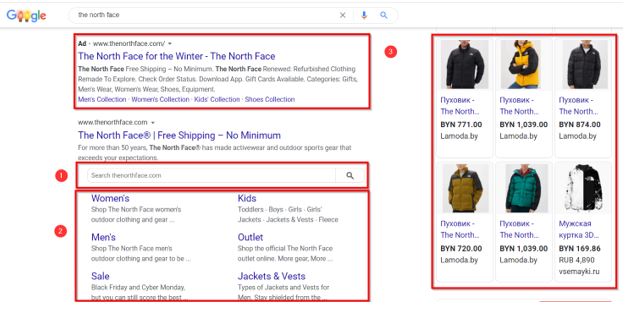
2. Search box
The Search box is a fairly unnoticeable search bar that you get in your snippet along with sitelinks. Probably, most people ignore it on a page crammed with images. However, for some cases it serves its purpose — to generate clicks to the right page. There is a specific markup for the Search box that helps crawlers identify the search bar you want used for the Search box feature. Sometimes Google shows the search bar itself, without specific implementations.
3. Ads
Google Ads may get displayed in blocks either above or below the organic search results, marked accordingly. They may turn up among any type of Google SERPS, in case the search engine believes you have a purchase intent, and your query matches those of a running ads campaign.
While Google Ads campaign is appropriate for any type of business, large or small, Google shopping ads are suitable for large e-commerce websites.
Paid shopping results appear as enriched ads to the right of the organic listings or above them. These ads contain names, images of the products, prices and links. Paid shopping ads are usually displayed for queries with straightforward commercial intent.
4. Knowledge Graph Results
The Google Knowledge Graph is a knowledge database developed by Google to improve the search engine results. It collects information from a variety of sources (in the first place Wikipedia and official sources) about a prominent entity. The panel usually contains the company name, the type of business, the logo, a link to the company’s site, a description, a list of the entity’s social net profiles, and a “People also search for” box.

The Knowledge Graph panel usually shows up for navigational, mostly branded queries. It is great for companies that target branded keywords: stores, books, movies, music bands, etc. It does as much good for non-commercial entities, like museums or travel guides.
The Knowledge Graph box is powerful in terms of traffic and brand authority: it makes searchers deeply involved and serves as a strong signal of the company’s reliability.
5. Travel searches
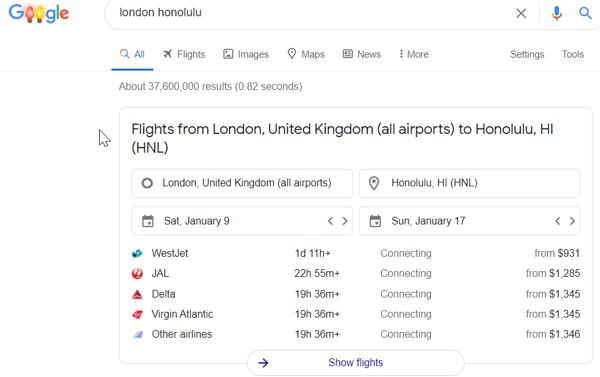
Google flights
Google Flights appeared in 2011 following Google’s purchase of ITA matrix software. The tool lets searchers find flight schedules and prices through Google search. The Flights box contains the names of airlines/travel agencies and links to their sites, flight duration, and fares.
Hotel ads
Looking to book a hotel in a remote destination? Google will display an option to book an apartment right in the SERP, which is actually a part of branded Knowledge Graph listings for hotels. Google gets either a pay-per-click or a commission whenever a reservation is made via Google listings.
Route box
If the searcher is looking for a route to get from one place to another, Google will often show the Route box, with a map, directions, means of transportation, and even schedules for a bus or a train. These results actually come from Google Maps. Getting listed within the Route box is free for transportation companies.
6. The local business
Local packs in Google results are a must-have for any business with a physical location. It is composed of a Google map and the top three local listings.
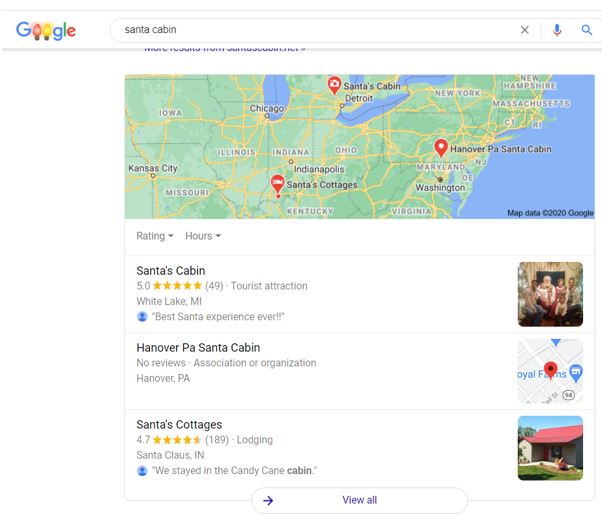
Usually Google displays the local Knowledge Graph for branded queries when the searcher is looking for a business in a specific location, not just asking for general information about the company.
A local Knowledge Graph usually includes:
- a photo;
- a pinned map;
- the company website;
- directions on Google Maps for it;
- review score;
- a business type;
- a short description;
- contact details;
- open hours;
- a few excerpts from Google reviews;
- a “People also search for” box.
7. Rich answer
These are text answers to a question in a query that Google has found somewhere within a page. Most answers pop up with a link to the website, and when you proceed to them, you will find the respective paragraph highlighted in yellow.
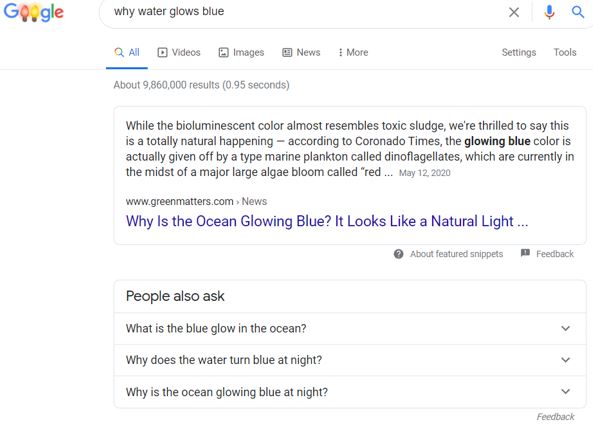
Once your page gets a featured snippet, you will typically have loads more traffic, as the link to your website will be the actual #1 search result.
8. People also ask
The People also ask box is a common SERP feature that answers questions similar to the original query. The box can appear all over the first page of search results. You can expand the box and read the answer, meanwhile, more similar questions will appear at the bottom of the box. The answer will include the link to the source site, so it can increase your CTR to a certain extent.
9. Rich snippets
If you own a cafe or promote a blog, the structured data markup is just the right thing to make your links stand out from the crowd. Have a 5-star rating next to your venue, or a cheerful feedback, or a fashionable image to showcase — all these will make your site visually appealing. And actually number 1 on the SERP. Believe it or not, your traffic will skyrocket.
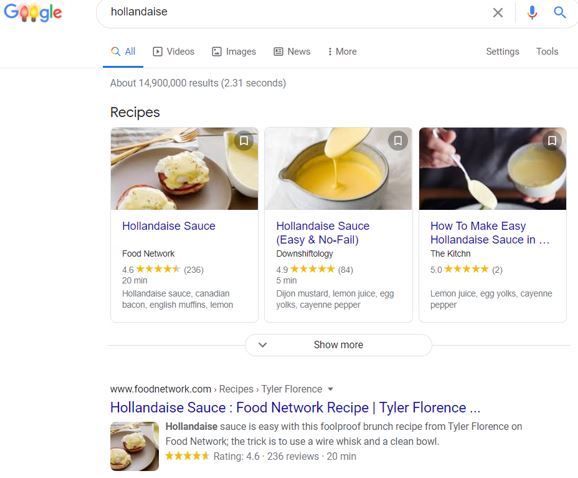
10. Featured video
Try to Google your favorite music hit or a movie trailer. You will see a large embedded video at the top of the search results. It only works for TV and musicians, and hardly for any other type of promotion. The highlighted videos contain an URL (leading directly to the official source), some information about the track and the artist, the genre, and top streaming platforms for download. Plus you can reach the video right in the SERP and read the lyrics.
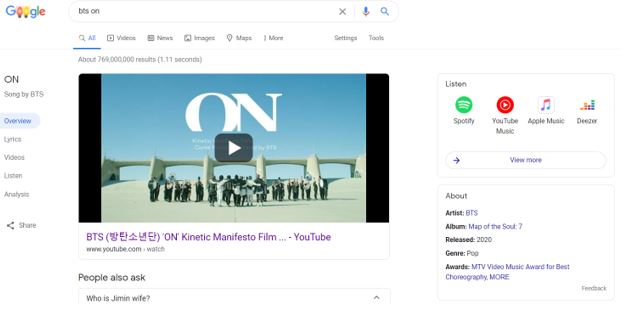
11. Trending Videos
Other trending video results can turn up integrated with organic search results and have a custom snippet, containing the title of the video episode, a thumbnail, the date published and the publisher. If video content is what you do seriously on your site, then you will need a bit of YouTube optimization to leverage your video results in Google.
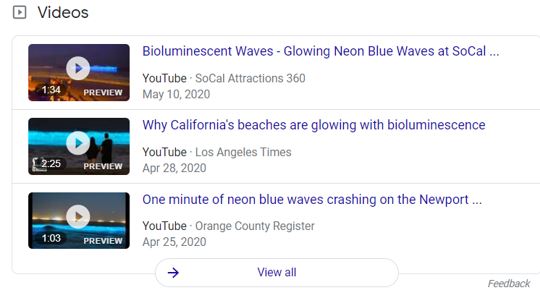
12. Images
This feature works for stock photo sites, artists, bloggers. Image result boxes are often seen in Google’s organic SERP and appear on the first results page, now often in its lower part, pushed down by Knowledge Graph, People Also Ask, etc. The photo results will link to Google Images mixed with Related searches graph and related topics.
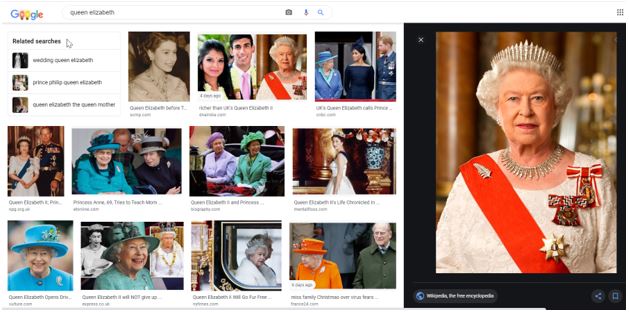
13. Social listings
Social nets have been evolving intensively a lot over the past years, no wonder social results have evolved as well. Currently you can get listed in the separate Twitter box, and show up with other top social profiles via Knowledge Graph panel.
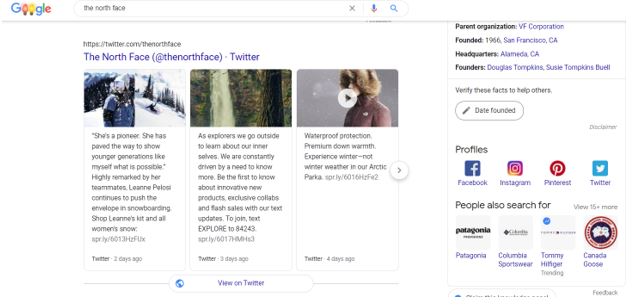
14. Top stories
The top news results turn up once in a while for queries that match some concurring news posts. Such results usually appear all over the first page and have up to three links. The links can be enhanced with a thumbnail image. The main requirement is that your content should be of high quality, fresh, and unique.
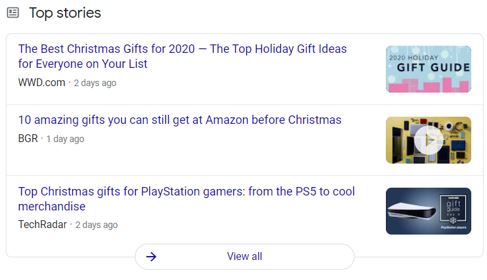
How to check SERPs fast.
For a single page, you can have a quick check with Google’s Rich Results Test.
However, if you need to check multiple keywords and pages, and moreover, if you want to monitor SERPs constantly, you will need a SERP tracker, and here I’ll show you a good one.
Note: How to get started.
To have your free check, download and install SEO PowerSuite’s Rank Tracker. Next, launch the tool, paste your site URL to create a project. At the next step, you will need to add some head keywords that your site is already ranking for, and the software will collect the first basic information about your rankings and keywords.
Basically, there is a separate keyword research module that will help you discover more target keywords. Once you have them all picked and sorted, move them all to the Rank Tracking module. Here, you will be able to record their rankings, compare organic search and PPC stats, and, here we approach the gist of the story – check SERPs and monitor your competitors’ top rankings.
In the Keywords and Ranking tab, right-click anywhere on the columns’ header and add the Google SERP features to your workspace.
Go to Preferences > Rank Checking Mode, and make sure that you uncheck Track organic results only box, and check the Track multiple results for keyword box. Check Record SERP data to start collecting SERP history. (Mind that to use SERP Analysis, you will need a Professional or Enterprise Rank Tracker license. Anyway, you can try it free from the beginning). Once you’ve done this, SERP features will be tracked along with the regular organic results every time you check rankings.
![]()
Some more settings. When you are checking local results, make sure you define your location and popular search engines correctly. Go to Preferences > Preferred Search Engines and click Add Custom next to Google. In the Advanced Settings window that pops up, enter your city or area, and click OK.
![]()
To refresh your rankings, select all or some particular keywords and click Check Rankings. When the check is complete, in the Google SERP Features column you will see different kinds of icons that stand for various SERP features (if any). Your check results for SERP features will look like this:
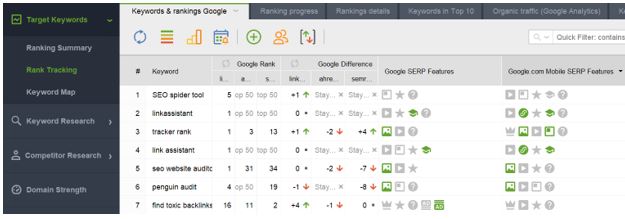
When the icon is grey, it means that there is a rich feature present on this SERP for your target keyword, but the result is not yours. When the icon is green — you’ve got it!
Plus, with subsequent checkups, you will get notified if the site enters or leaves the top 10 results on the SERP.
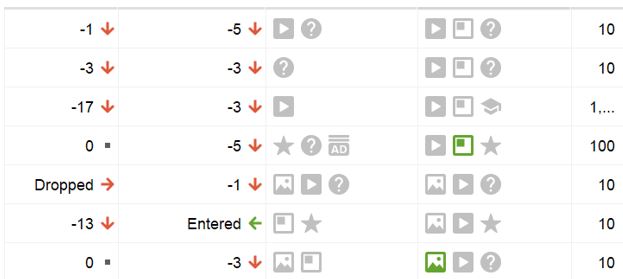
In the lower part of your screen you will have a Keyword Difficulty tab, pretty convenient for quick SERP analysis. You will see top ten sites ranking for the selected keyword. In the Rank column you will get the icon for the rich result present for the page. The ranking page URL is beside, so you can quickly check what it looks like.
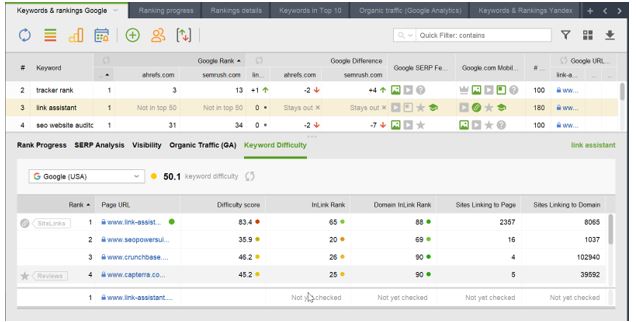
How to get featured on Google SERPs
While all these types of rich results have all benefits of their own, you should implement your pages correctly, with the best rich feature option for you. Below are a few steps for your rich features implementation.
-
Claim Google My Business listing.
If you are a local store, selling products or services, this is what you must have done immediately. When filing the Google My Business profile:
- Add a unique description with a link to your official site;
- Pick the right category for your business type;
- Upload a quality image and cover photo;
- Check that your address, phone number, and opening hours are correct and consistent with all other local business directories;
- Have them updated when changed.
-
Invite customers to rate your services.
Ask your customers to rate or leave reviews about your products or service. Only good ones, I should remark.
-
Implement structured data to get into featured snippets.
Implement Schema markup and Open Graph for socials to enrich your SERP snippets with images, ratings, reviews, or whatever industry-specific data.
Thanks to Google, you don’t need to be a programmer if you need to mark up the structured data on a site. You can use Structured Data Markup Helper. Before adding the schema markup chunk of HTML to your pages, remember to preview your snippets. Copy and paste your page’s source code into Google’s Testing Tool, and check.
-
Have your social accounts verified.
If your business pages on social networks are filled in appropriately and maintain live communication with users, Google trusts them and suggests just like your official pages right in the Knowledge Graph.
-
Answer related questions for your target keywords.
You can run the SEO PowerSuite keyword tracker to find out popular questions about your target keywords and intertwine them with your content, or add a FAQ. Go to the Keyword Research module and select the Related Questions keyword research method. Choose People Also Ask method, add a few keywords and click Search. As a result, you will receive tons of suggestions related to your keywords.

Add the questions and concise, direct answers to them. The structure is very important here. Google will pick up paragraphs tagged with proper heading, lists, and tables from your content.
-
Optimize your pages.
With Google’s mobile-first indexing, your pages have to be feather-light and lightning-fast. For the one part, you have to implement all traditional SEO elements, like tags, titles, with all your target keywords right in the content. For the other part, you have to ensure that your site is error-free and corresponds to all modern requirements: no broken links, SEO-friendly URLs, web-optimized images.
You can do all the analysis and optimization with software for SEO. Check out SEO PowerSuite’s Website Auditor. The tool combines an SEO crawler and content editing module. This way you can check individual pages for their optimization score, structured data, and other relevant SEO information. And then you can revamp the page and optimize it on the go, observing how the optimization score is improving.
Hope you’ve enjoyed this guide. Have you ever noticed how rich features influenced your traffic? Please share your experience in the comments!

